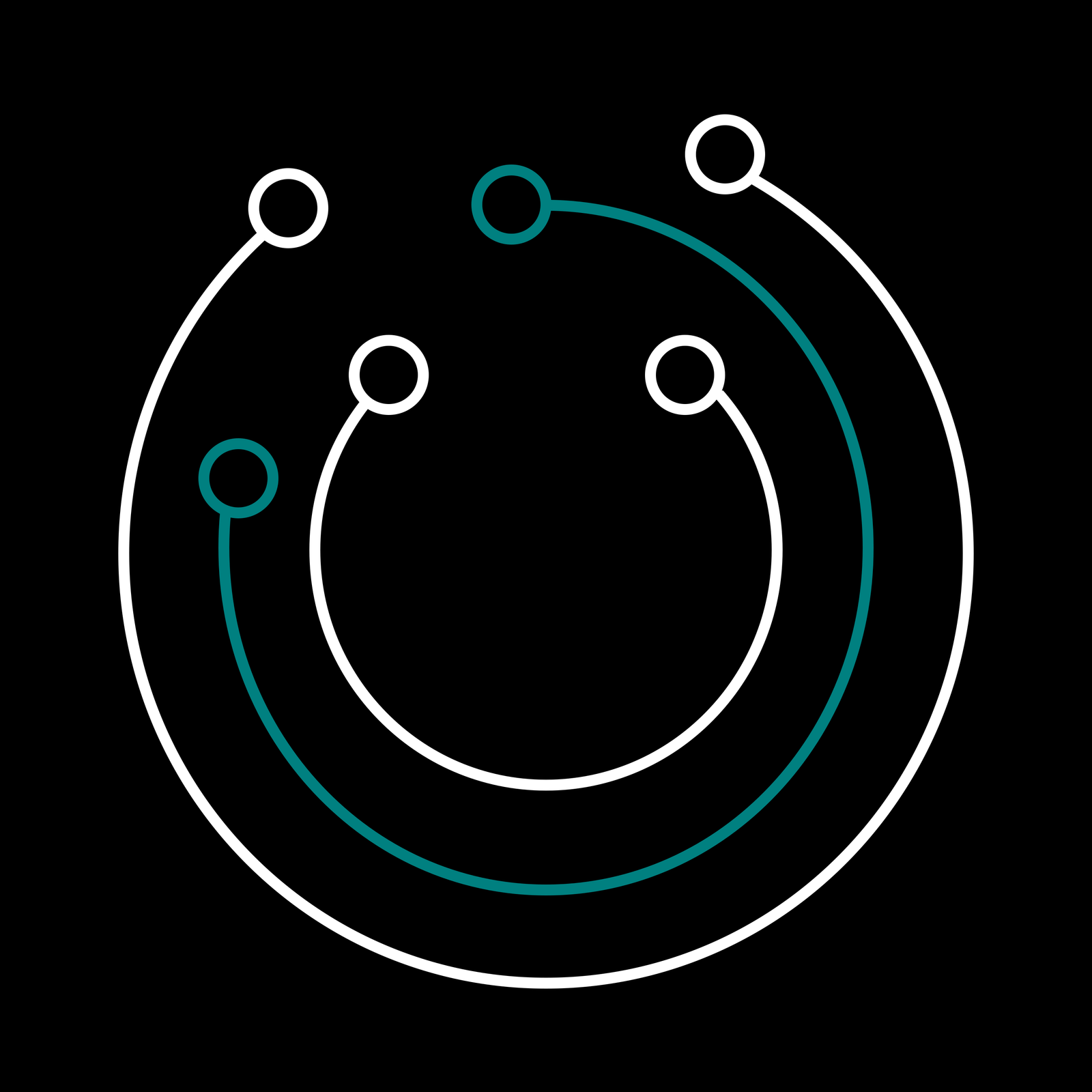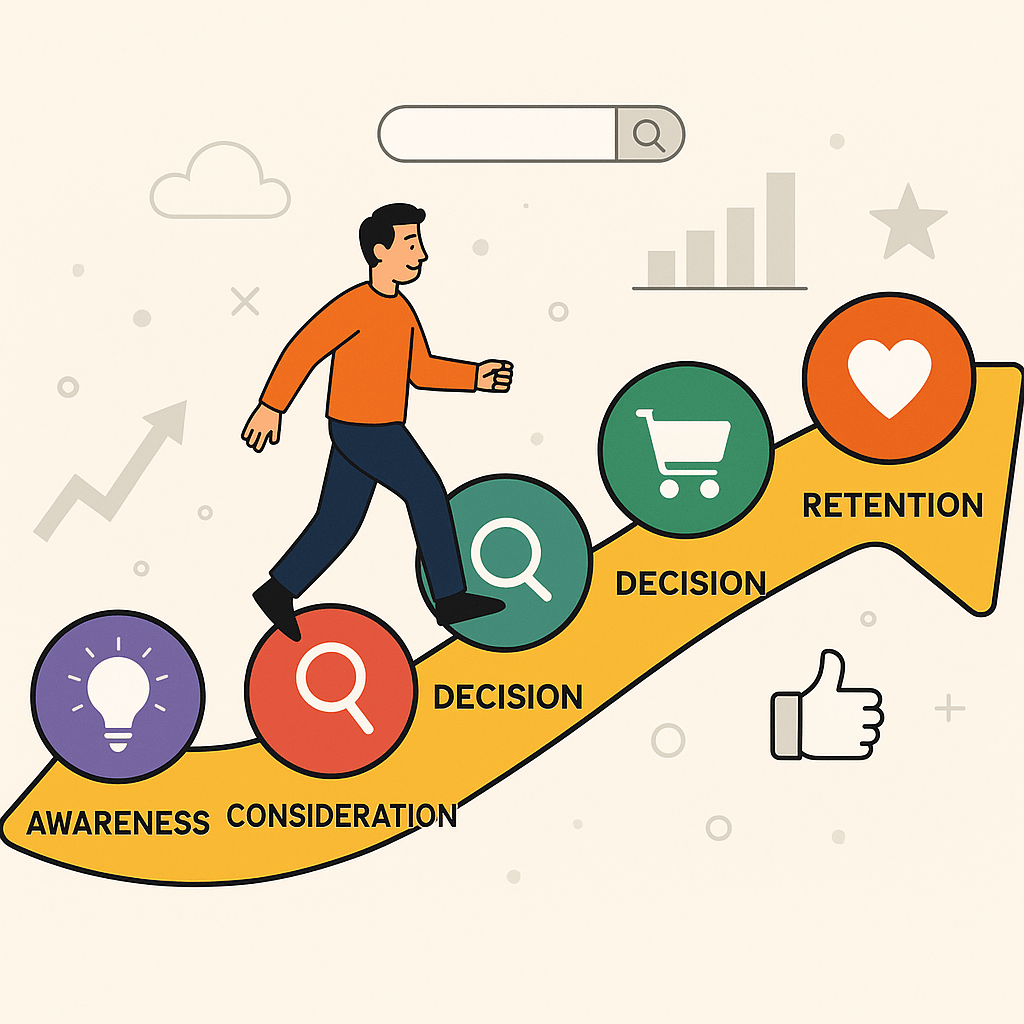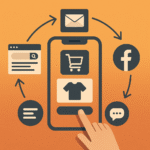Understanding your customer’s path to purchase is no longer a luxury—it’s a necessity. In today’s hyper-connected, cross-device reality, the consumer journey rarely follows a straight line. Instead, it zigzags through numerous touchpoints—spanning organic searches, social media, customer reviews, email marketing, PPC ads, and digital interactions—with complexity that often overwhelms internal marketing teams.
Yet, businesses that thrive aren’t just watching these journeys—they’re mapping them, optimizing them, and seamlessly guiding users from “Who are you?” to “I’ll never shop anywhere else.”
But here’s the twist: Not all journey maps are created equal. Some are too shallow. Others are painfully generic. Most, unfortunately, fail to turn passive interest into profitable action.
That’s where TDC (The Digital Connections) steps in. TDC has developed a proprietary, data-backed framework that combines digital analytics, behavioral psychology, and practical marketing experience to decode your customer’s actual intent—and transform it into conversions you can count.
In this playbook, you’ll discover how to:
- Define your customer personas with real behavioral context
- Pinpoint and optimize every stage of the buying journey
- Leverage data and psychology to improve conversion rates
- See real-world applications that deliver measurable outcomes
Let’s get started.
What is the Customer Journey?
Before diving into the strategic toolkit, let’s align on what we mean by “customer journey.”
At its core, the customer journey is the sum of experiences every prospect goes through when interacting with your brand—from the very first impression to post-purchase conversations. It’s about understanding both the what (actions taken) and the why (motivations behind them).
The 5 Core Stages of the Customer Journey:
- Awareness – The customer identifies a problem or need and begins searching for answers or options.
- Consideration – The research begins. They start weighing your business against competitors.
- Decision – It’s crunch time. The customer is ready to make a purchase and is looking for validation through social proof, pricing, or convenience.
- Retention – Your post-purchase experience kicks in. Are they delighted enough to come back?
- Advocacy – A great experience pays forward. Happy customers share their satisfaction, turning into vocal promoters.
But realistically, few consumers move through this funnel in a perfectly linear fashion. They might jump from awareness to decision due to an urgent need—or drop off completely after the consideration phase if the messaging doesn’t resonate.
Understanding this ebb and flow is what separates mediocre customer experiences from remarkable ones. TDC’s customer journey methodology goes deeper than just touchpoints. It decodes emotional drivers, decision triggers, and content friction zones to create maps that not only guide customers—but inspire action.
▶️ NLP Optimization Tip: Throughout this article, we’ve incorporated contextual phrases like “conversion journey,” “funnel optimization,” and “emotional touchpoints” to align with Google’s phrase-based indexing, enhancing search visibility and semantic clarity.
Why Mapping the Customer Journey Matters
Here’s a simple truth: What gets measured gets improved.
If you aren’t deliberately designing and iterating on the customer journey, you’re defaulting to a reactive model—patching problems instead of preventing them.
In contrast, brands that proactively build their journey map see distinct benefits. According to a 2022 Gartner study:
- 82% of companies that mapped the customer journey improved customer retention
- 63% saw an increase in average order value (AOV)
- 30% reported reduced churn and customer service costs
But let’s not stop at stats. Let’s explore tangible advantages:
1. Align Sales, Marketing & Customer Success
With a cohesive map, your teams no longer work in silos. Content becomes targeted. Sales conversations become relevant. Support anticipates needs before complaints arise.
🔍 Entity Attribute Alignment: Here, the entity “customer journey” has attributes like alignment, optimization, and relevance—enhancing semantic understanding for NLP algorithms.
2. Identify Friction and Lost Opportunities
Journey mapping often reveals inconsistencies or broken user experiences. Maybe it’s a confusing checkout process. Or a lack of mobile optimization that drives bounces.
These nuanced insights are only visible when you visualize the full experience and evaluate each segment incrementally.
3. Maximize ROI Across Channels
Every touchpoint carries a cost—whether it’s ad spend or content creation. Optimizing the journey turns generic investments into high-leverage moments where you’re meeting the customer at just the right time with just the right message.
Still need proof this works? Let’s jump into a real-world transformation.
Case Study: How a SaaS Company Increased Conversions by 54% with TDC’s Strategy
Let’s unpack how TDC’s approach unlocked growth for a SaaS company stuck in a common performance plateau.
Client: FlowMetrics (B2B SaaS Analytics Platform)
FlowMetrics provides detailed project analytics to mid-sized agencies and enterprise project managers. While their website attracted consistent organic traffic, very few site visitors requested demos or became qualified leads.
🔍 Challenge: High traffic, low engagement. Their bounce rate on the landing page was 67% and demo signups hovered below 0.7%.
Here’s what TDC did:
Phase 1: Customer Insight Audit
TDC conducted qualitative interviews with 20 recent customers. The insights? Most users were unclear about how FlowMetrics differed from competitors. Their core value proposition—a time-saving dashboard integration—was buried three paragraphs deep on the homepage. Ouch.
| Entity | Attribute | Value | |-|-|-| | FlowMetrics | Bounce Rate | 67% | | FlowMetrics | Demo Conversion Rate | 0.7% | | FlowMetrics | Customer Sentiment | Confused about value proposition |
Phase 2: Journey Mapping & Behavioral Heatmaps
Using tools like Hotjar and FullStory, TDC spent two weeks tracking session recordings, email behavior, and click patterns.
- Users dropped off immediately after hitting the landing page.
- Scroll depth averaged only 30%.
- Decision-stage CTAs were misaligned with actual buyer concerns.
Phase 3: Strategic Experience Reboot
TDC customized the journey using these tactics:
- Rewrote landing page copy centered on buyer pain points.
- Moved key differentiators above the fold.
- Added mid-funnel content like ROI calculators and interactive demos.
- Set up lifecycle sequences based on CRM activity—re-engaging dormant leads with personalized tips.
Results Within 90 Days:
- Demo signups rose from 0.7% to 1.08%—a 54% increase
- Retention increased by 23%, as onboarding flows became proactive
- Customer churn fell by 18%
This wasn’t about flashy design or “more content.” It was about meeting customers where they were—and guiding them forward with empathy, clarity, and timing.
That’s the TDC difference.
How to Map the Customer Journey Using TDC’s Proven Framework: A Deep Dive
You’ve seen the “what” and the “why.” You’ve witnessed the transformative power of a meticulously mapped customer journey through our FlowMetrics case study. Now, it’s time to roll up your sleeves and master the “how.”
TDC’s framework isn’t just a checklist; it’s a cyclical process of deep discovery, strategic implementation, and continuous optimization. We move beyond generic templates to build a living, breathing map that reflects your unique audience’s emotional drivers and intent signals. Let’s break down each stage of the journey with advanced tools, concrete examples, and the nuanced optimization tactics that deliver results.
Stage 1: Awareness – The “Aha!” Moment
In the awareness stage, your customer has a need or a problem but may not even know a solution exists. They aren’t searching for your product; they’re searching for an answer. Your goal here is not to sell, but to educate and resonate.
Tools for Deep Discovery:
Go beyond Google Analytics. Use SEMrush or Ahrefs to identify the exact question-based keywords your audience is using (“why are my projects always over budget?”). Leverage AnswerThePublic to visualize these questions and concerns. Social listening tools like Brand24 or Talkwalker can reveal unprompted conversations about industry pain points in forums and social networks.
Example in Action:
A local HVAC company wouldn’t target “buy AC unit” at this stage. Instead, they create content around “why is my house so humid?” or “what does it mean if my AC is making a buzzing sound?” This problem-aware content positions them as a helpful authority before a sale is ever considered.
Optimization Tactic:
Implement a topical authority content strategy. Cluster all your question-based, informational content around core pillars (e.g., “Home Comfort,” “AC Maintenance”). This creates a powerful, semantically-linked ecosystem that signals to Google you are a comprehensive resource, dramatically boosting organic visibility for early-funnel terms.
▶️ NLP & Phrase-Based SEO Tip: Weave natural-language phrases like “problem-aware content,” “early-funnel questions,” and “educational resources” into your meta descriptions, H2s, and body copy to capture the searcher’s initial intent.
Stage 2: Consideration – The “Show Me” Phase
Now, the customer understands their problem and is evaluating potential solutions. They know what a “project management tool” is, and now they’re comparing “Asana vs. ClickUp vs. FlowMetrics.” This stage is a battle of relevance and differentiation.
Tools for Deep Discovery:
This is where Hotjar or FullStory become critical. Analyze session recordings to see where users hover, click, and drop off on comparison pages. Use CRM data to review sales call transcripts—what questions do consideration-stage leads consistently ask? These are your golden nuggets of intent.
Example in Action:
FlowMetrics discovered through interviews that buyers were confused about their unique dashboard integration. Their optimization wasn’t a guess; it was a direct response to a known friction point. They created a side-by-side comparison chart and an interactive demo, moving directly from a generic claim to a specific, tangible differentiator.
Optimization Tactic:
Develop comparison content that is genuinely useful, not just a sales pitch. Create detailed blog posts, webpages, and even videos that fairly compare your solution to alternatives. This builds immense trust. For your product pages, use tools like UsabilityHub to A/B test which value propositions (e.g., “Saves 10 hours a week” vs. “Integrates in 5 minutes”) resonate most with your audience.
▶️ Entity-Based SEO Tip: Strengthen your entity around “solution comparison.” Use schema markup for FAQPage and Product to directly answer comparison questions in SERPs, and ensure your content explicitly names and compares entities (competitor products, features, prices) to establish topical authority and relevance.
Stage 3: Decision – The “Yes, You” Moment
The customer has shortlisted their options and is ready to choose. Their primary need is validation and a frictionless path to purchase. Risk reduction is your primary goal.
Tools for Deep Discovery:
Scrutinize your checkout analytics and form analytics (using a tool like Google Tag Manager to track micro-conversions). Where are the leaks? Use Mouseflow to identify form field friction. Analyze your customer review sentiment with a tool like MonkeyLearn to understand what final factors tipped the scale in your favor.
Example in Action:
An e-commerce brand might find a 20% cart abandonment rate at the shipping information page. A deep dive reveals that hidden shipping costs, revealed only at this stage, were the culprit. The optimization? A clear “Free shipping on orders over $50” banner site-wide and a shipping calculator earlier in the funnel.
Optimization Tactic:
Deploy risk-reversing language at every step. This includes trust badges (SSL seals, payment logos), Guaranteed Assurance messaging (“free returns,” “60-day money-back guarantee”), and injecting specific customer testimonials that address final doubts (e.g., “I was worried about installation, but their support team guided me through it in minutes”). Make the act of saying “yes” as effortless as possible.
Stage 4 & 5: Retention & Advocacy – The “Love You” Loop
The journey doesn’t end at a sale; that’s where the most profitable phase begins. Retention and advocacy transform single buyers into a loyal community that fuels sustainable growth.
Tools for Deep Discovery:
Move beyond basic email open rates. Use Net Promoter Score (NPS) surveys via Delighted or SurveyMonkey to segment customers into promoters, passives, and detractors. Analyze behavior in your app or service using Mixpanel or Amplitude to identify “aha!” moments that correlate with long-term retention.
Example in Action:
A software company notices that users who complete their onboarding tutorial within 3 days have a 90% retention rate at 6 months. They then use their CRM (HubSpot or Intercom) to automate a triggered email sequence that proactively guides users who haven’t completed the tutorial, effectively boosting retention across the board.
Optimization Tactic:
Build a systematic referral program. Instead of a generic “Refer a friend” link, create a personalized referral dashboard for happy customers. Offer value that benefits both parties (e.g., “Give your friend $20 off their first order, get $20 credit for yourself”). This formalizes the advocacy process, turning organic word-of-mouth into a scalable, trackable growth channel.
▶️ Phrase-Based SEO Tip: Capture post-purchase intent by optimizing for phrases like “[Your Product] how to use,” “advanced tips for [Your Product],” and “[Your Product] customer success stories.” This content nurtures existing customers, reduces support costs, and attracts new visitors who are already solution-aware and highly qualified.
By adopting this layered, empathetic approach to each stage, you stop pushing customers down a funnel and start guiding them along a path—a path built on data, psychology, and a genuine desire to solve their problems. This is how you build a brand that doesn’t just win customers, but wins advocates for life.
Operationalizing Your Customer Journey Map: Building a Cross-Functional Growth Engine
You’ve done the deep work. You’ve interviewed customers, mapped their emotional highs and lows, and identified the critical friction points and moments of truth. You have a beautiful, insightful customer journey map.
Now what?
A map locked in a PDF or pinned to a wall is a museum piece—interesting to look at, but incapable of driving change. The true value of journey mapping is only realized when it becomes the operational heartbeat of your organization. It’s about moving from a static document to a dynamic system that aligns your people, informs your processes, and powers your technology.
In this final installment, we’ll show you how to transform your insights into action, creating a living framework that adapts with your customers and scales with your growth.
Step 1: Assemble Your Cross-Functional Journey Team
The biggest mistake a company can make is treating the customer journey as a “marketing project.” The journey touches every part of your business, and so must your team.
The Core Squad:
This isn’t a committee of VPs. It’s a working group of hands-on practitioners.
- Marketing Owner: Brings the top-of-funnel insight and content strategy.
- Sales Representative: Provides frontline feedback on customer questions and objections.
- Customer Success Agent: Offers a direct line to post-purchase pain points and successes.
- Product Developer: Understands the technical feasibility of proposed experience changes.
- Data Analyst: Ensures every hypothesis and result is grounded in quantitative truth.
The Operational Rhythm:
This team should meet bi-weekly for a 60-minute “Journey Sync.” The agenda is simple: review one stage of the journey against key performance indicators (KPIs), discuss new qualitative feedback, and prioritize one experiment to run in the next two weeks. This creates a constant, manageable pace of iteration.
Step 2: Build Your Tech Stack for a Single Source of Truth
Your journey map needs data to live. Disparate systems create disconnected experiences. Your goal is to create a unified customer profile that follows them across every touchpoint.
The Foundation: A Connected CRM.
Your Customer Relationship Management platform (HubSpot, Salesforce) is the central nervous system. It must integrate with your marketing automation, your customer support software, and your analytics.
The Insight Amplifiers:
- Analytics & Session Replay: Google Analytics 4 for the ‘what,’ combined with Hotjar or FullStory for the ‘why.’
- Feedback Tools: Use Delighted or SurveyMonkey for structured NPS and CSAT surveys. Use a tool like Canny or Savio to collect, categorize, and route feature requests from customers directly to your product team.
- Interaction Platforms: Intercom or Drift for proactive chatbots and messaging that can serve contextually relevant content based on the user’s journey stage.
The Magic of Integration:
When your CRM shows that a customer read a specific help article (tracked from GA4), then asked a question via chat (logged from Intercom), and then submitted a feature request (from Canny), your teams have a complete picture. This allows for personalized follow-up that feels effortless, not invasive.
Step 3: Implement a Cycle of Continuous Iteration
A journey map is a hypothesis, not a prophecy. The market changes, customer expectations evolve, and your map must adapt. Embrace a build-measure-learn loop.
Build:
Based on your Journey Sync, design a small-scale experiment to improve one micro-moment. This could be an A/B test on a landing page headline, a new automated email for dormant users, or a revised sales script for a common objection.
Measure:
Define success before you launch. Is the primary KPI a higher click-through rate, a lower cost-per-lead, or improved customer satisfaction? Use your analytics dashboard to monitor performance against a control group.
Learn:
This is the most critical step. Did the experiment work? Why or why not? Document the learning—even (and especially) if the test failed—and add it to your shared knowledge base. This learning then informs the next cycle of iteration.
Real-World Application:
Imagine an e-commerce brand learns through session replays that users are abandoning their cart after clicking the “Calculate Shipping” button. Their hypothesis is that shipping costs are a surprise. They build an experiment: show a “Free shipping on orders over $50” notification on the product page. They measure the cart abandonment rate and average order value. They learn that AOV increased by 15% and abandonment dropped, validating the hypothesis. This change is then permanently baked into the consideration stage of their operational journey map.
The TDC Difference: From Map to Growth Engine
While many agencies deliver a report and disengage, TDC believes in embedding capability. Our engagement doesn’t end with a presentation. We work alongside your newly formed cross-functional team to establish these rhythms, configure your tech stack for insight, and instill a culture of customer-obsessed experimentation.
We don’t just give you a map; we teach you how to navigate, ensuring you can confidently steer your business toward long-term, customer-centric growth long after our initial work is done.
Your Customer Journey Awaits.
The path to purchase is more complex than ever, but it’s also filled with more opportunity. By understanding, mapping, and ultimately operationalizing the customer journey, you stop shouting into the void and start having meaningful conversations at every single touchpoint.
You are no longer just selling a product or service. You are delivering an experience worth remembering, sharing, and returning to.
Ready to map your path to growth? Contact TDC today for a free, no-obligation Customer Journey Assessment. Let’s build something remarkable together.
Discover more from The Digital Cauldron
Subscribe to get the latest posts sent to your email.





